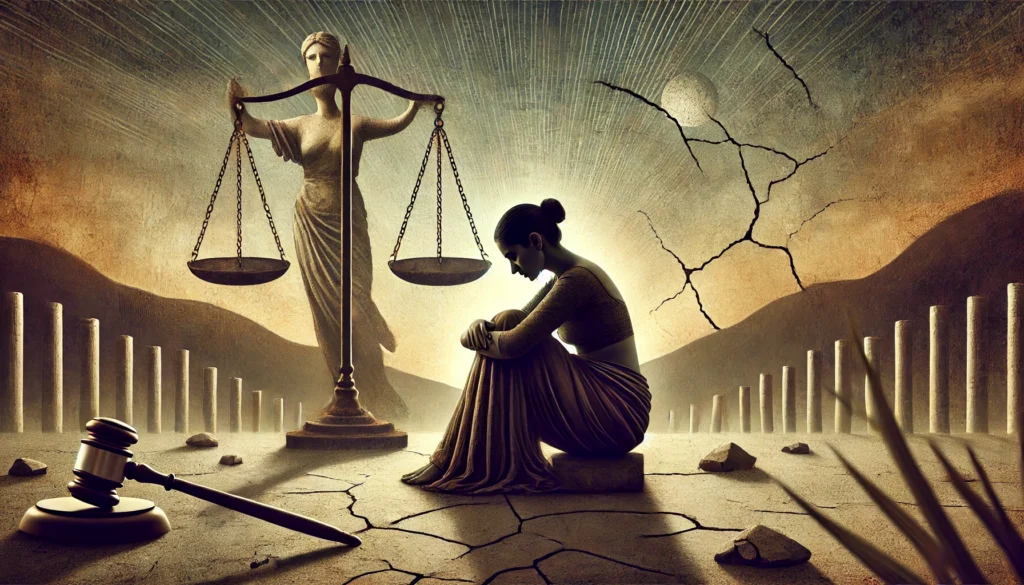Published on 15th August 2025
Authored By: Shivangi Sundaram
GJ Advani Law College, University of Mumbai
ABSTRACT
Custodial deaths in India expose deep institutional pathologies beyond legal gaps, rooted in colonial-era policing mentalities and systemic impunity. Forensic analyses reveal consistent evidence suppression: 60% of deaths occur before judicial remand (NCRB 2000–2020), with medical reports often masking torture as “suicide” or “illness.” Entrenched corruption enables evidence tampering, while political patronage shields perpetrators. Marginalized communities face disproportionate targeting, constituting 72% of victims per National Campaign Against Torture (NCAT). Reform requires dismantling structural enablers—implementing independent investigations, mandatory body cameras, and prison condition overhauls—alongside cultural transformation from a “force” to a “service” ethos. Ratifying the UN Convention Against Torture (UNCAT) remains urgent but insufficient without accountability enforcement.
INTRODUCTION
Custodial death is defined as the death of an individual while in the custody of law enforcement agencies, either during police detention or judicial custody. It is one of the worst violations of fundamental human rights and constitutional morality in India. The dignity of human beings and the welfare of all humanity have always been part and parcel of the cultural milieu of our ancient Indian civilization. Barbaric and inhuman punishments were completely foreign to our culture. While India has a strong constitutional framework and well-settled judicial protection, it still reports alarming cases of custodial violence and deaths which reveal entrenched systemic failures in its criminal justice system. The trend moves beyond raw statistical information, marking an institutional accountability crisis, cultural impunity within law enforcement, and an enduring disconnect between principles of law and ground realities. This report examines the multifaceted dimensions of custodial deaths in India, analyzing the existing legal framework, judicial interventions, institutional mechanisms for accountability, and the urgent reforms needed to uphold the sanctity of the right to life guaranteed under Article 21 of the Constitution.
CONSTITUTIONAL AND STATUTORY SAFEGUARD AGAINST STATE EXCESSES
The constitutional foundations protecting individuals from state excesses are unequivocal. Article 21 guarantees the right to life and personal liberty, interpreted expansively by the Supreme Court to encompass the right to live with dignity without torture and degrading treatment. Article 22 provides specific protection against arbitrary arrest and detention, mandating production before a magistrate within 24 hours, the right to consult legal counsel, and the right to be informed of arrest grounds. Article 20(3) explicitly prohibits self-incrimination, thereby serving as a shield against coercive interrogation methods. In the landmark judgement of Selvi v. State of Karnataka, the Court ruled that compulsory administration of certain neuroscientific techniques like narcoanalysis, polygraph, and brain mapping tests violate this right, as they constitute testimonial compulsion. Article 14 ensures equality before the law and prohibits arbitrary state action. These constitutional protections are not abrogated upon arrest; they are enforceable against the state which has an affirmative obligation to safeguard those in custody.
The Supreme Court, in landmark judgments like D.K. Basu v. State of West Bengal (1997), has repeatedly emphasized that custodial torture is “a naked violation of human dignity” and erosive of the rule of law. The guidelines issued in D.K. Basu included mandatory arrest memos, notification of family, medical examinations, and magistrate oversight which were designed to operationalize these constitutional protections. Similarly, in Nilabati Behera v. State of Orissa (1993), the Court stipulated the vicarious liability of the state for custodial deaths, mandating compensation and affirming that sovereign immunity cannot override fundamental rights. Joginder Kumar v. State of U.P. (1994) emphasized that arrest cannot be a routine act and must be justified by necessity, while Sunil Batra v. State (UT of Delhi) (1978) extended constitutional safeguards against inhuman treatment, torture and punishments unusual from prison detainees. However, the enforcement of these rights and orders by the Supreme Court remains weak, particularly for marginalized communities who are disproportionately affected by custodial violence.
Existing statutory frameworks fail to effectively address custodial violence and deaths due to fragmentation and lack of strong deterrents. Major provisions include:
- Sections 330 (voluntarily causing hurt to extort confession) and 331 (voluntarily causing grievous hurt to extort confession) of the Indian Penal Code (IPC), now incorporated as Section 120 in the Bharatiya Nyaya Sanhita (BNS), 2023.
- Section 302 (murder) and Section 304 (culpable homicide not amounting to murder) of the IPC (Sections 103 and 105 BNS) apply when custodial death is caused by police action.
- Section 348 IPC (Section 127(8) BNS) penalizes wrongful confinement to extort confession.
The Code of Criminal Procedure (CrPC), 1973, now largely replaced by the Bharatiya Nagarik Suraksha Sanhita (BNSS), 2023, contains crucial procedural safeguards.
- Section 176(1A) CrPC (Section 196 BNSS) mandates a mandatory judicial inquiry by a Judicial Magistrate (not Executive Magistrate) into every custodial death, rape, or disappearance.
- Section 167 CrPC (Section 187 BNSS) strictly limits police remand duration (generally 15 days maximum, extendable only under specific conditions up to 60 or 90 days depending on the offence severity).
- Section 49 CrPC (Section 46 BNSS) prohibits unnecessary restraint during arrest, and
- Section 54 CrPC (Section 53 BNSS) guarantees the right to a medical examination.
The Protection of Human Rights Act (PHR Act), 1993, established the National Human Rights Commission (NHRC) and State Human Rights Commissions (SHRCs) with powers to investigate custodial death complaints, visit detention centres, recommend disciplinary action or prosecution, and award compensation. However, the NHRC’s recommendations lack binding force, significantly hampering its effectiveness.
BEYOND THE STATISTICS: THE REAL-LIFE IMPACT OF IMPUNITY
Despite these legal provisions, the statistical reality paints a grim picture of systemic failure and impunity. Data compiled by the NHRC and National Crime Records Bureau (NCRB) reveals a persistent crisis. The NHRC reported 2,152 deaths in judicial custody and 155 deaths in police custody in 2021-22 alone. Uttar Pradesh consistently records the highest numbers, followed by states like Maharashtra, Gujarat, Bihar, and Tamil Nadu. Disturbingly, the NCRB data covering 2000-2020 shows 1,888 reported custodial deaths nationwide. While FIRs were registered against police personnel in 893 cases, charge sheets were filed in only 358, and a mere 26 convictions were secured over two decades. A significant 60% of these deaths occurred before the detainee was even produced before a court (“persons not on remand”). The National Campaign Against Torture (NCAT) documented a daily average of five custodial deaths in 2019. Official figures tend to attribute fatalities to “illness” (40%) or “suicide” (29% in police custody, increasing to 36% in recent years) but human rights groups argue it to be a mask underlying torture, neglect, or inadequate medical care. The conviction rate remains abysmally low, estimated at only 0.23% of reported cases over five years (2016-2021). This data underscores a profound accountability deficit where deaths occur with alarming regularity, but legal punishment for offenders is non-existent.
ROOT CAUSES OF CUSTODIAL DEATHS
The causes of custodial deaths are deeply intertwined with systemic pathologies within law enforcement and the justice system. Police brutality and the widespread use of “third-degree” methods – physical assault, torture (beatings, electric shocks, positional torture), and psychological pressure – to extract confessions or punish suspects remain the primary direct cause. A near-total lack of accountability sustains this culture of violence. Internal police disciplinary mechanisms are opaque and ineffective, often resulting in minor punishments like suspension or transfer rather than criminal prosecution. Investigations into custodial deaths are frequently conducted by the police themselves or affiliated agencies, leading to biased outcomes, evidence tampering, and witness intimidation. The police often control the crime scene, initial reports, and access to the deceased, creating insurmountable hurdles for impartial inquiry.
Political interference shields errant officers, with transfers and promotions often based on loyalty rather than merit. Abysmal conditions in police lock-ups and prisons – severe overcrowding, poor sanitation, inadequate food, and absence of basic medical facilities – lead to deaths from neglect and preventable disease. Deliberate denial of timely medical care to injured or ill detainees is a recurrent factor. Individuals from marginalized communities (Dalits, Adivasis, religious minorities, and the poor) are disproportionately targeted and vulnerable due to social prejudice and lack of legal recourse. Poor training of police in human rights norms, investigation methods, and dealing with mental disorders aggravates the problem.
The absence of a comprehensive standalone anti-torture law, despite India signing the UNCAT in 1997, leaves a critical legislative void. While the 273rd Law Commission Report (2017) drafted a Prevention of Torture Bill recommending ratification of UNCAT, amending the CrPC and Evidence Act (including introducing Section 114B to reverse the burden of proof for injuries in custody), and stringent punishments, it remains unimplemented. This legislative loophole allows perpetrators to exploit existing provisions, making convictions under general homicide or hurt charges difficult due to high evidentiary thresholds.
JUDICIAL INTERVENTIONS OVER THE PERIOD
The Indian judiciary has played a pivotal, though at times restricted, role in combating custodial deaths through activist interpretations of constitutional and statutory law. Beyond the landmark D.K. Basu guidelines, the Supreme Court in Prakash Singh v. Union of India (2006) issued seven important directions to police reform intended to keep the force away from political influence and increase accountability. These included fixed tenures for Directors General of Police and other key officers, separation of investigation and law-and-order functions, the establishment of independent Police Establishment Boards for transfers/postings, and constitution of State and District-level Police Complaints Authorities (PCAs) to inquire into serious misconduct, including custodial death. However, implementation by states has been dilatory and patchy, significantly undermining the ruling’s potential impact.
In Arnesh Kumar v. State of Bihar (2014), the Court addressed the issue of arbitrary arrests, laying down guidelines for police to follow before arresting for offences punishable with imprisonment of less than seven years. The judgement emphasized the principle of “innocent until proven guilty”. People’s Union for Civil Liberties (PUCL) v. State of Maharashtra (2014) reinforced that investigations under Section 176 CrPC (196 BNSS) must be conducted by Judicial Magistrates, and not Executive Magistrates, to ensure independence. The Court has consistently held that the burden of explaining injuries or death in custody lies heavily on the authorities (State of M.P. v. Shyamsunder Trivedi, 1995). It has condemned fake encounters as “cold-blooded murders” requiring the harshest punishment (Prakash Kadam v. Ramprasad Vishwanath Gupta, 2011).
The case of Khatri and Ors. v. State of Bihar, popularly known as “Bhagalpur Blindings” is particularly notable because of the scandalous nature of the case and its impact on jurisprudence related to state liability. The case involved the horrific act of police blinding undertrial prisoners with acid in the late 1970s and early 1980s. The Supreme Court’s intervention established the principle of state vicarious liability for police actions that violate fundamental rights, particularly under Article 21 of the Constitution. While these pronouncements provide a strong jurisprudential foundation, their effectiveness is hampered by poor enforcement, procedural delays in the justice system, and resistance from police and political establishments.
INSTITUTIONAL ACCOUNTABILITY MECHANISMS: DEFICIENCIES AND FAILURES
Institutional mechanisms for accountability, while existing on paper, suffer from severe limitations. The NHRC/SHRCs, despite their mandate, lack prosecutorial powers and binding enforcement authority. Their recommendations for compensation or action are often ignored by state governments. Police Complaints Authorities (PCAs), mandated by Prakash Singh, remain largely non-functional or toothless in most states, lacking adequate resources, independence, and authority. Internal police accountability units are widely perceived as biased and ineffective, prioritizing departmental loyalty over justice. The requirement under the PHR Act and NHRC guidelines for immediate reporting (within 24 hours) of custodial deaths and video recording of autopsies is frequently violated. Magistrates, who are entrusted with the pivotal function of supervising remand and conducting inquiries, often perform their duties perfunctorily, relying heavily on police versions due to heavy workloads, inadequate training, and sometimes, lack of independence. The absence of widespread, functional CCTV coverage in police stations and interrogation rooms, despite Supreme Court suggestions, removes a crucial potential source of objective evidence. The medical profession also faces challenges; doctors conducting autopsies or examining detainees often face pressure, intimidation, or lack the requisite training to identify and document signs of torture accurately, leading to compromised reports that aid cover-ups.
WAY FORWARD
To comprehensively address custodial deaths, India must pursue urgent multi-dimensional reforms. Legislatively, this requires ratifying the UN Convention against Torture (UNCAT) and enacting a stringent standalone anti-torture law, as proposed by the Law Commission, which clearly defines torture (physical, mental, psychological), imposes severe penalties like life imprisonment, reverses the burden of proof for custody injuries (Section 114B, Evidence Act), guarantees victim/witness protection, and provides enforceable compensation, with corresponding amendments to the CrPC/BNSS and Evidence Act.
Simultaneously, police reforms demand the full implementation of the Prakash Singh directives, ensuring fixed tenures for chiefs, functional and independent Police Complaints Authorities (PCAs) with investigative and prosecutorial recommendation powers, performance evaluations rewarding integrity, and complete separation of investigation from law-and-order duties. Institutionally, the NHRC and SHRCs must be granted statutory powers to make binding recommendations on prosecution and compensation, alongside significant resource augmentation, while magisterial oversight requires revitalization through specialized training, mandatory surprise inspections of custodial facilities, and strict enforcement of procedural safeguards like timely production and medical examinations.
Technological integration, specifically universal CCTV coverage with audio in all police stations and lock-ups plus secure, accessible footage storage, and promoting body-worn cameras during arrests, is crucial for transparency. Critically, intensive and recurring training for all police personnel on human rights, constitutional values, scientific investigation, non-coercive interrogation, and the consequences of custodial violence is essential, coupled with accessible complaint mechanisms and robust witness protection for victims’ families, alongside streamlined, generous, and prompt statutory victim compensation schemes.
Furthermore, prison conditions necessitate improvement by tackling overcrowding through bail reforms and alternatives to incarceration, while guaranteeing basic standards of hygiene, sanitation, nutrition, healthcare, regular medical screening, and access to independent doctors. Ultimately, a fundamental cultural shift within the police force – moving from a colonial “force” mentality to a democratic “service” orientation that respects human rights and views custodial safety as a core duty, underpinned by strong leadership enforcing accountability – is vital for sustainable change.
CONCLUSION
Custodial deaths signify a profound betrayal of India’s constitutional compact, revealing institutional decay and a culture of impunity. Despite strong Supreme Court jurisprudence, a critical implementation gap persists. Ending this requires more than legal reforms like an anti-torture law; it demands transforming police culture, ensuring effective oversight bodies (NHRC, PCAs), and unwavering political will prioritizing human rights. While technology (CCTVs) aids transparency, moral commitment is essential. Upholding life and dignity under Article 21, even for the accused, is foundational. Eradicating custodial deaths is a fundamental test of India’s commitment to constitutional governance, the rule of law, and human dignity, requiring sustained multi-faceted efforts.
REFERENCES
[1] Selvi v. State of Karnataka (2010) 7 SCC 263 (India).
[2] D.K. Basu v. State of West Bengal (1997) 1 SCC 416 (India).
[3] Nilabati Behera v. State of Orissa (1993) 2 SCC 746 (India).
[4] Joginder Kumar v. State of U.P. (1994) 4 SCC 260 (India).
[5] Sunil Batra v. State (UT of Delhi) (1978) 4 SCC 494 (India).
[6] Prakash Singh v. Union of India (2006) 8 SCC 1 (India).
[7] Arnesh Kumar v. State of Bihar (2014) 8 SCC 273 (India).
[8] People’s Union for Civil Liberties (PUCL) v. State of Maharashtra (2014) 10 SCC 635 (India).
[9] State of M.P. v. Shyamsunder Trivedi (1995) 4 SCC 262 (India).
[10] Prakash Kadam v. Ramprasad Vishwanath Gupta (2011) 6 SCC 189 (India).
[11] Khatri (II) v. State of Bihar (1981) 1 SCC 627 (India).
[12] Indian Penal Code 1860, ss 302, 304, 330, 331, 348 (India).
[13] Bharatiya Nyaya Sanhita 2023, ss 103, 105, 120, 127(8) (India).
[14] Code of Criminal Procedure 1973, ss 49, 54, 167, 176 (India).
[15] Bharatiya Nagarik Suraksha Sanhita 2023, ss 46, 53, 187, 196 (India).
[16] Protection of Human Rights Act 1993 (India).
[17] United Nations Convention Against Torture and Other Cruel, Inhuman or Degrading Treatment or Punishment 1984 (UNCAT).
[18] Law Commission of India, Report No. 273: Prevention of Torture Bill (2017).
[19] National Human Rights Commission (India), Annual Report 2021–22 (2022).
[20] National Crime Records Bureau (India), Crime in India: Statistics on Custodial Deaths (2000–2020) (2021).
[21] National Campaign Against Torture (NCAT), India: Annual Report on Torture 2019 (2020).




